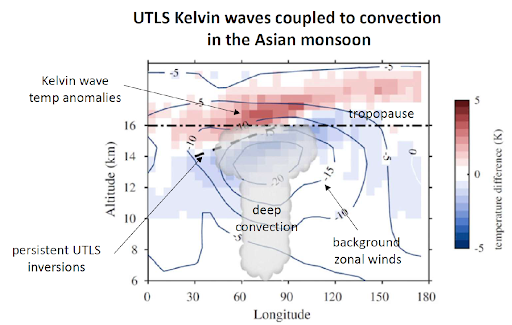Persistent UTLS inversions in the Asian monsoon linked to convectively forced Kelvin waves
High vertical resolution temperature measurements from GPS radio occultation show frequent upper-tropospheric inversions over the equatorial Indian ocean during the summer monsoon season (June-September). The Indian ocean inversions occur episodically several times each summer, persisting with a time scale of 1–2 weeks, and are quasi stationary or slowly eastward moving. These inversions influence the large-scale UTLS circulation and transport in the monsoon region, and are also evident in satellite ozone measurements. Our analyses show that the inversions are linked with planetary-scale Kelvin waves, with coherent temperature and zonal wind anomalies centered over the equator and a characteristic eastward phase tilt with height (Figure 1). Correlations with outgoing longwave radiation (OLR) show that strong inversions are linked to enhanced deep convection over the equatorial Indian Ocean, preceding the inversions by 2–6 days. While eastward traveling Kelvin waves forced by tropical convection are well known, the UTLS features in the monsoon region are unusual in that they are quasi-stationary and remain phase-locked to the convection. This behavior is explained by Doppler shifting within the local easterly monsoonal winds (Figure 1), and this phase-locking may provide a positive feedback between the UTLS circulation and the underlying convection. This behavior may help explain the preference for large-scale organized convection over the equatorial Indian ocean during the monsoon season.

Figure 1. Schematic of coupling between large-scale convection over the equatorial Indian ocean and UTLS thermal structure (colors) associated with planetary-scale Kelvin waves. Although Kelvin waves typically propagate eastwards, in this situation they are Doppler shifted by the background easterly zonal winds to remain quasi-stationary and locked to the deep convection.
References
Newton, R., and Randel, W.J., 2020: Observations of upper-tropospheric temperature inversions in the Indian monsoon and their links to convectively forced quasi-stationary Kelvin waves. J. Atmos. Sci., DOI: 10.1175/JAS-D-20-0042.1